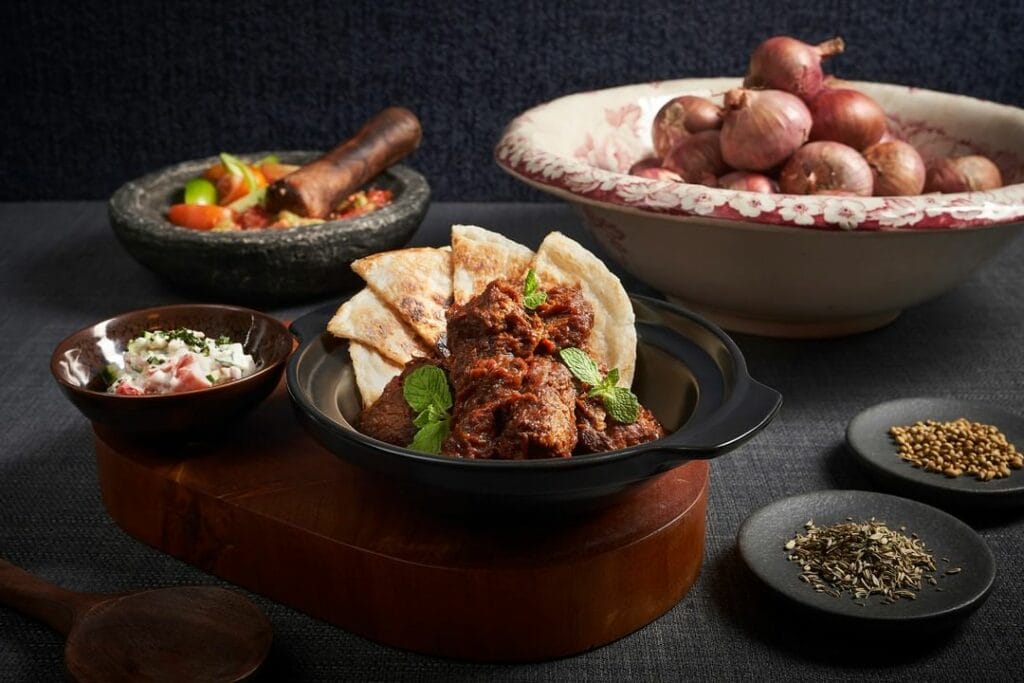“I am proud to be cooking something close to my heart and roots,” said Chef Alan Chan on the importance of preserving cultures through food.

Chef Alan Chan
In the gastronomic world, culture plays a huge significance in shaping our food intake. The food you eat every day can tell you a lot about where you come from. There is more of a connection between food and culture than you may think.
Recently, we have had a chance to chat with Alan Chan, Head Chef of Rempapa, a restaurant that focuses on marrying Chinese, Peranakan, Eurasian, Indian, and Malay flavours. In the conversation, he shared details about his career, how he innovates dishes and how he celebrates cross-cuisine cuisines
1.Tell us about yourself and what inspired you to choose a career in culinary arts.
My late grandmother was a great cook and growing up with her inspired me to be a chef. She was a very gifted cook – she could whip out a myriad of dishes from different cultures because of where she lived and her multi-cultured neighbours. We were neighbours with a grandaunt who taught my grandma how to prepare Peranakan dishes. And, we also had Hakka, Malay, Cantonese, and Chindian neighbours that inspired her cooking.
After graduating from Taylor’s University in Malaysia, I headed to Singapore and got my first job at Pizzeria Mozza at Marina Bay Sands. Then, I joined the one-Michelin-starred and World’s 50 Best Restaurant, Burnt Ends by Dave Pynt as Junior Sous Chef.
I got another great opportunity in 2017 to work with Chef Rishi Naleendra at Kotuwa, where I became Head Chef of the Sri Lankan restaurant. During my time at Kotuwa, Rishi collaborated with Chef Damian, who was at Restaurant Kin. I had the chance to work on this collaboration and immediately fell in love with Chef Damian’s food and culinary philosophy.
While taking a short break in between jobs, I returned to dine at his latest outlet, Rempapa. He knew I was looking for a new adventure, so he offered me the Head Chef role at Rempapa.
I am happy to be leading the team at the celebrated Singapore Heritage restaurant and I’m proud to be cooking food that is close to my heart and roots. Whenever I cook at Rempapa, it reminds me of my grandma, my old neighbours, and the food that comforted me when I was a kid – these memories encourage me to preserve and celebrate heritage food.
2. As a chef, what are your thoughts on heritage cuisines?
Heritage cuisine is endangered. These days, we have so many options for modern and trendy food which are Instagrammable and great for sharing on social media. While traditional, heritage dishes are seen as boring, dated, and “ugly”, and are slowly forgotten over the years.
Heritage food requires not only a lot of patience to cook but also knowledge and understanding of ingredients. For example, not many people will know that there is more than one type of chilli at the markets. There is so much variety and each has its purpose, such as cili kerinting, cilli padi, cili setan, and cili kampung. Cooking heritage food also requires experience that brings consistency to the dishes. Different types of ginger or galangal affect the final taste of the dish. Young ginger is less spicy, and old ginger has a stronger taste and it is spicier.
3. What do you think of the importance of preserving cultures through food for generations to come?
It’s important to educate the next generation. It is a part of preserving our cultures and the food that our forefathers used to eat. Once we stop cooking heritage dishes that have been passed down for generations, the following generations will not know how to cook these dishes. The challenge of cooking heritage food is that most dishes are extremely labour intensive. These days, most people prefer easy recipes that are fool proof, especially with assistance from modern machines and techniques such as sous vide.
4. What will be your recommendations from Rempapa’s menu?
When you dine at Rempapa, one of the dishes you must try is Baca Assam. It is a long-lost Eurasian recipe of braised beef cheek in tamarind sauce which requires 12 hours of slow cooking. I recommend it because this dish goes so well with rice. The meat is fork tender, and the sourness of tamarind will whet your appetite and balance the richness of the beef cheek.
5. We believe the festival was a happy hunting ground for Malaysians to get a feast for their appetite. Could you tell us about your menu creation for PASSPORT TO FEAST: SG At the Yard that has been brought to the Malaysian foodies?
There were 4 dishes offered on the menu. First, there was the Inchi Kabin, which is a well-known Peranakan deep-fried chicken. Interesting note: its name came from ‘encik kabin’ which translates to ‘mister cabin’.
The second dish was a Singaporean Nyonya laksa. The dish originated in the Katong and Joo Chiat neighbourhood, which was home to a largely Peranakan and Eurasian community.
Next, we offered Lamb Shoulder Rendang with Tater Tots. Indonesian-style slow-cooked lamb rendang was served over tater tots, so the dish was like an Asian take on loaded fries.
The last dish was a traditional Eurasian Sugee Cake.
6. If you had the opportunity to plan a cross-culture cuisine menu, what are some of the dishes you would include in the menu?
I would like to include duck tsukune with kicap manis glaze (grilled minced duck meat on a skewer with Malay sweet soy sauce glaze). It highlights local ingredients and flavours, cooked in the style of the classic Japanese yakitori. Another dish is the lamb shoulder rendang with tater tots – one of the dishes at PASSPORT TO FEAST: SG At the Yard. It’s a modern way of enjoying heritage flavours and the combination of flavours and textures is very addictive.
Discover more stories here.




